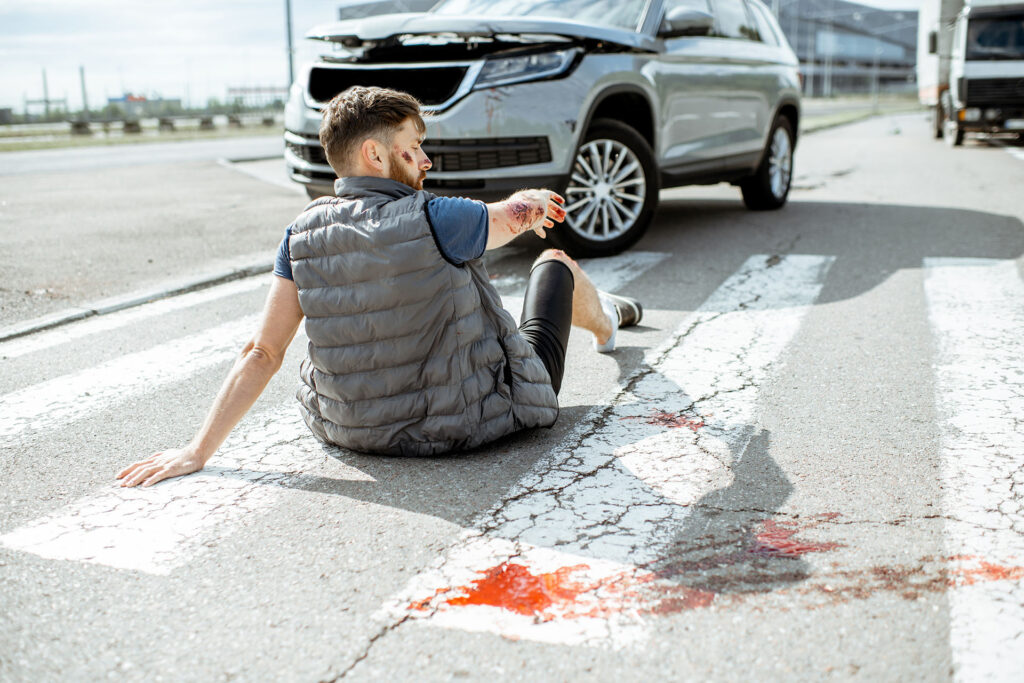Yes, you can sue someone for a hit-and-run in New York. Hit-and-run accidents can leave victims with significant injuries and property damage, often requiring legal recourse to recover compensation. Victims have the right to pursue legal action against the negligent driver responsible for the incident.
Below, we'll explore the process of suing for a hit and run in New York, including the necessary steps and considerations.
What is classed as a “hit-and-run” accident in New York?
A hit-and-run accident occurs when a driver involved in a collision fails to stop at the scene and provide their contact information, vehicle registration, and insurance details to the other parties involved. This applies to accidents involving vehicles, pedestrians, or property damage.
Under New York law, drivers involved in accidents are legally obligated to stop immediately at the scene of the collision.
Additionally, drivers must render reasonable assistance to any injured individuals and report the accident to the police if it results in injury, death, or property damage exceeding $1,000. Failing to fulfill these obligations constitutes a hit-and-run offense, which can result in severe legal consequences.
Victims of a hit-and-run should contact our car accident lawyer in Brooklyn as soon as possible to help build a strong case against the negligent party.
How to sue for a hit-and-run in New York
Here's a short guide on how to sue for a hit-and-run:
- Identify the At-Fault Driver: Identifying the driver responsible for a hit-and-run can be difficult, especially if there were no witnesses or surveillance cameras.
- Contact the Police: The police will investigate the incident, review any available surveillance footage, and follow up on leads to locate the at-fault driver.
- Consider Hiring a Private Investigator: If the police investigation does not yield results, private investigators can conduct a more focused search and may have access to additional resources.
- Consult an Attorney: Engage a lawyer who specializes in hit-and-run cases. They will guide you through the legal process, help you understand your rights, and determine the appropriate damages to seek.
- Draft and File the Complaint: Your attorney will draft a complaint outlining your case against the at-fault driver, detailing the incident, the injuries and damages sustained, and the compensation you seek. This document is then filed with the appropriate New York court.
- Serve the Defendant: Once the complaint is filed, the at-fault driver must be formally notified, or "served," with the lawsuit documents. This step is crucial for the legal process to proceed.
- Discovery Process: Engage in the discovery process where both parties exchange information relevant to the case. This may include interrogatories, depositions, and requests for documents.
- Negotiate Settlement: Often, cases are settled out of court. Your attorney will negotiate on your behalf to reach a fair settlement. If a settlement cannot be reached, the case will proceed to trial.
- Trial and Judgment: If the case goes to trial, your attorney will present your case, and a judge or jury will determine the outcome. If successful, a judgment will be made in your favor, and the court will award you the appropriate compensation.
- Collect Compensation: Once you have a judgment in your favor, your attorney will assist you in collecting the awarded compensation from the at-fault driver. This may involve garnishing wages, placing liens on property, or other legal methods to ensure you receive the damages owed.
Additional reading: average settlement when hit by a drunk driver
Steps to take after a hit-and-run
Experiencing a hit-and-run accident can be disorienting and stressful. However, taking prompt and decisive action is important for your safety and to strengthen your legal position.
Here are the essential steps to take after a hit-and-run:
- Ensure Safety: Prioritize safety for yourself and any passengers by moving your vehicle to a safe location away from traffic. Check for injuries and administer first aid if necessary. If possible, try to remember details about the fleeing vehicle, such as its color, make, and license plate number.
- Call the Police: Immediately report the hit-and-run to the police by dialing 911 or the non-emergency line. Provide as much detail as possible about the incident, including the location, time, and description of the fleeing vehicle. Cooperate fully with law enforcement officials and provide any requested assistance in their investigation.
- Gather Evidence: While waiting for the police to arrive, gather as much evidence as you can to support your case. Take clear photos and videos of the accident scene, including any damage to your vehicle and any injuries you or your passengers sustained. Obtain contact information and statements from any witnesses to the accident. Also check nearby businesses or residences for surveillance cameras that may have captured the incident.
- Notify Your Insurance Company: Contact your insurance company as soon as possible to report the hit-and-run accident. Provide them with all the gathered evidence and details of the accident. Be honest and thorough in your communication with your insurer, as this will help expedite the claims process and ensure that you receive the maximum compensation available under your policy. Your insurance company will guide you through the claims process and provide assistance in repairing your vehicle and covering medical expenses if you have the appropriate coverage.
- Consult an Attorney: If you're wondering, "should I get a lawyer for a minor car accident," it's wise to consider seeking guidance from a qualified attorney who specializes in hit and runs. An experienced attorney can help you understand your rights, navigate the claims process, and pursue legal action against the at-fault driver if necessary. They can also provide invaluable advice on dealing with insurance companies and maximizing your compensation.
Contact our law firm as soon as possible for a free consultation with our car accident lawyer in Queens to discuss your potential claim.

Your rights as a victim
As a victim of a hit-and-run accident, you have certain rights that protect your interests and ensure you receive the compensation you deserve.
Right to sue
This allows you to seek compensation for various losses incurred due to the accident, including medical expenses, lost wages, property damage, and pain and suffering.
When considering how much can someone sue for a car accident, it's important to consult with a legal professional who can evaluate the specifics of your case and provide guidance on the potential compensation you might recover.
Civil lawsuits provide a legal avenue for holding the at-fault driver accountable for their actions and recovering financial compensation to help you recover from the incident.
Uninsured motorist coverage
In New York, uninsured motorist coverage can be invaluable for hit-and-run victims. This coverage helps protect you if the at-fault driver is uninsured or cannot be identified, providing compensation for your injuries and damages. It's essential to check and understand your insurance policy to ensure you have adequate uninsured motorist coverage in the event of a hit-and-run accident.
Seeking legal Guidance
If you're unsure about your rights or need assistance navigating the legal process after a hit-and-run accident, consider consulting with an experienced attorney who specializes in personal injury law.
They can provide valuable guidance on your legal options, help you understand your insurance coverage, and represent your interests in negotiations with insurance companies or in civil court if necessary.
Contact an attorney as soon as possible to discuss your next steps and to help understand your rights.
Criminal and civil ramifications for the at-fault party
In the aftermath of such incidents, the at-fault party may face both criminal charges and civil compensation claims.
Read More: who is at fault in a rear-end collision
Criminal charges for hit-and-run drivers
A hit-and-run driver may face criminal charges under New York law, depending on the severity of the incident. These charges can include leaving the scene of an accident (often classified as a misdemeanor or felony), reckless driving, vehicular assault, or even vehicular homicide if the accident results in serious injury or death.
Differentiating criminal penalties and civil compensation
Criminal penalties are imposed by the state and may include fines, license suspension or revocation, and imprisonment. These penalties aim to punish the offender for violating the law and deter future criminal behavior.
On the other hand, civil compensation involves seeking financial damages from the at-fault party to cover:
- Medical expenses
- Property damage
- Lost wages
- Pain and suffering
- Other losses incurred by the victim
Civil lawsuits are filed by the victim or their representative and aim to provide monetary compensation for the harm caused by the negligent driver.
Criminal charges and civil lawsuits are separate legal proceedings with different standards of proof and outcomes. While a hit-and-run driver may face criminal charges initiated by the state, the victim also has the right to pursue civil compensation through a lawsuit.
Statistics on hit-and-run accident in NY
Hit-and-run accidents in New York City have surged significantly, marking a concerning trend in recent years. Statistics reveal a staggering 25% increase in hit-and-run crashes since 2018. Shockingly, these accidents have resulted in the loss of lives, with a distressing tally of 220 fatalities reported in the current year alone.
Perhaps even more alarming is the disheartening statistic that only a mere 5% of drivers involved in these hit-and-run crashes are brought to justice. This statistic reflects the challenges law enforcement agencies face in apprehending and holding accountable the perpetrators responsible for fleeing the scene of accidents.
The low rate of resolution not only compounds the pain and suffering of victims and their loved ones but also undermines public trust in the justice system's ability to address such egregious acts.
By tackling the root causes of hit-and-run incidents and promoting a culture of accountability, we can strive to prevent future tragedies and ensure justice for victims of these senseless acts.
How we can help
Our experienced team is here to guide you through every step of the legal process, from navigating the complexities of the legal system to negotiating with insurance companies on your behalf.
We understand the importance of maximizing your compensation to cover medical expenses, property damage, lost wages, and other losses. With our expertise and dedication, we'll work tirelessly to ensure you receive the full compensation you deserve.
Don't wait to seek the help you need.
Contact us today for a free initial case evaluation, and let our car accident lawyer help you move forward from your hit-and-run accident with confidence.
FAQs
Does insurance cover hit-and-run in New York?
Yes, insurance can cover hit-and-run incidents in New York through mandatory uninsured motorist coverage and personal injury protection (PIP). Optional collision coverage can also help pay for vehicle repairs.
What if the negligent party doesn’t have insurance?
If the negligent party doesn't have insurance, uninsured motorist coverage can still provide protection. This coverage kicks in when the at-fault driver lacks insurance or cannot be identified, ensuring you receive compensation for damages.
What happens if you can’t reach a settlement?
If you can't reach a settlement through negotiations, you may need to pursue legal action. Consulting with a personal injury attorney can help you navigate the legal process and advocate for your rights in court.
Are there any specific laws if the vehicle struck was a parked car?
Yes, New York law requires drivers to stop and exchange information after hitting a parked car. Failing to do so can result in penalties, including fines and potential criminal charges, depending on the extent of the damage.
What is the statute of limitations on a hit-and-run in New York?
In New York, the statute of limitations for filing a personal injury claim related to a hit-and-run accident is typically three years from the date of the incident. It's crucial to act promptly and consult with an attorney to ensure you meet all legal deadlines.



